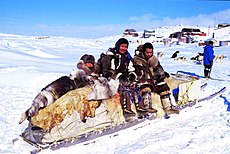Inuit in Canada
 Traditional qamutik (sled), Cape Dorset, Nunavut |
|
| Total population | |
|---|---|
| 150,636 | |
| Regions with significant populations | |
|
|
65,125 (2016) |
|
|
51,365 (2010) |
|
|
16,581 (2010) |
|
|
15,815 (2015) |
|
|
1,750 (2010) |
| Languages | |
| Greenlandic, Inuktitut, and other Inuit languages, Danish, English, French, Inuiuuk and various others | |
| Religion | |
| Christianity, Inuit religion | |
| Related ethnic groups | |
| Aleut and Yupik peoples | |
The Inuit (pronounced /ˈɪnju.ɪt/; Inuktitut: , "the people") are a group of culturally similar indigenous peoples inhabiting the Arctic regions of Greenland, Canada and Alaska. Inuit is a plural noun; the singular is Inuk. The Inuit languages are part of the Eskimo-Aleut family.Inuit Sign Language is a critically endangered language isolate spoken in Nunavut.
In the United States and Canada, the term "Eskimo" was commonly used by ethnic Europeans to describe the Inuit and Alaska's Yupik and Iñupiat peoples. However, "Inuit" is not accepted as a term for the Yupik, and "Eskimo" is the only term that applies to Yupik, Iñupiat and Inuit. Since the late 20th century, aboriginal peoples in Canada and Greenlandic Inuit consider "Eskimo" to be a pejorative term, and they more frequently identify as "Inuit" for an autonym. In Canada, sections 25 and 35 of the Constitution Act of 1982 classified the Inuit as a distinctive group of Aboriginal Canadians who are not included under either the First Nations or the Métis.
...
Wikipedia
